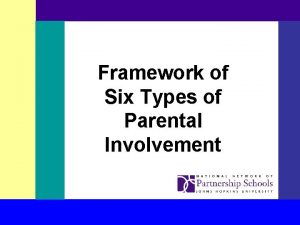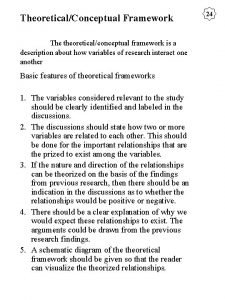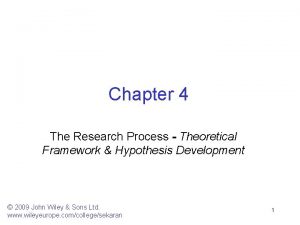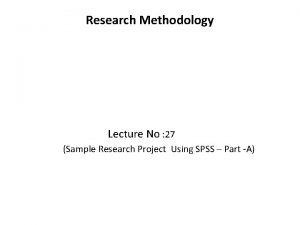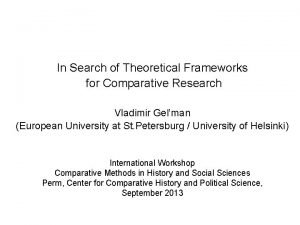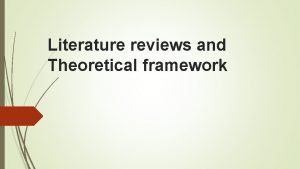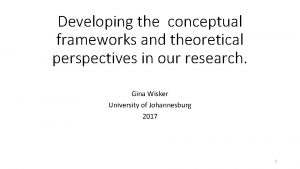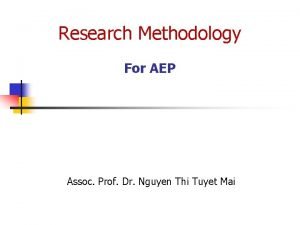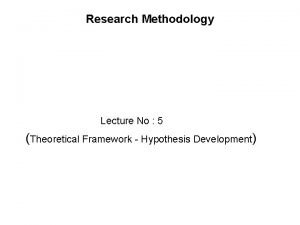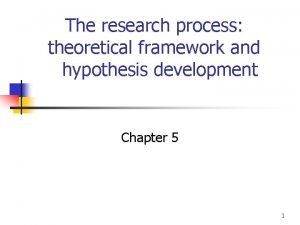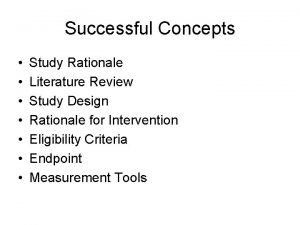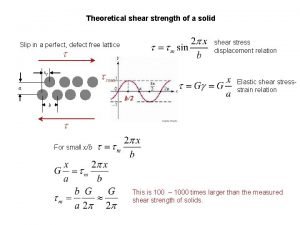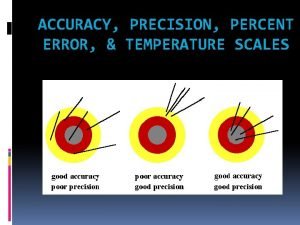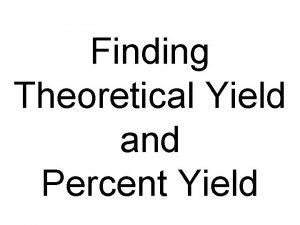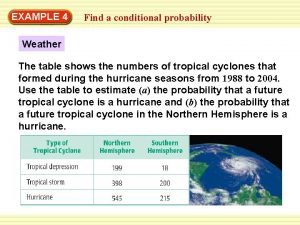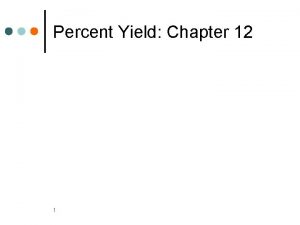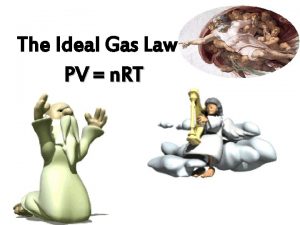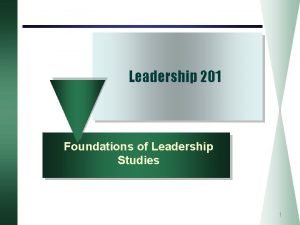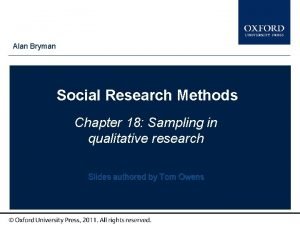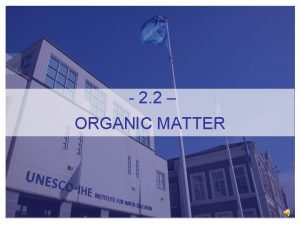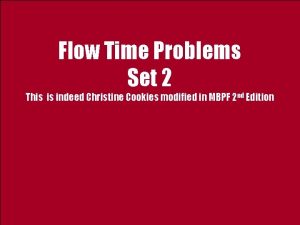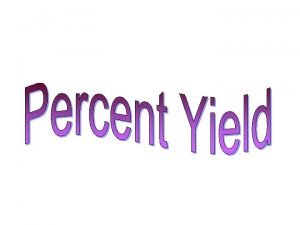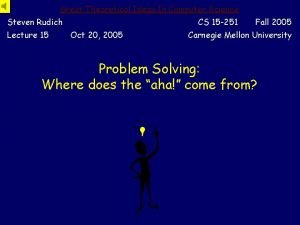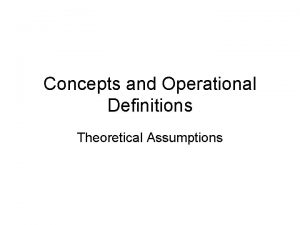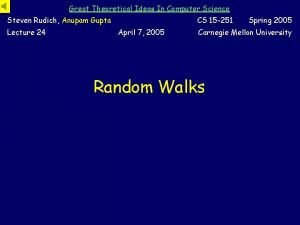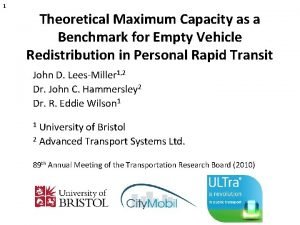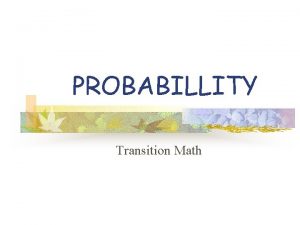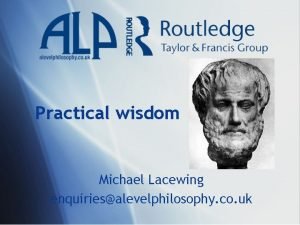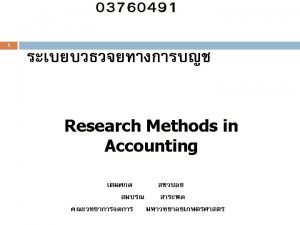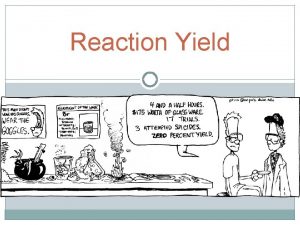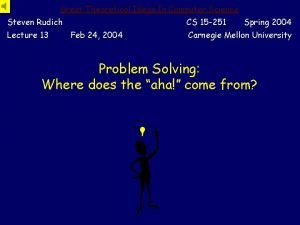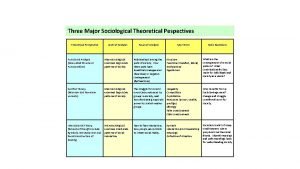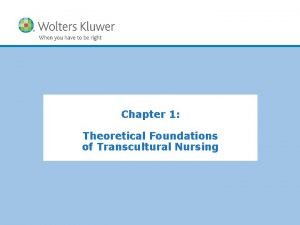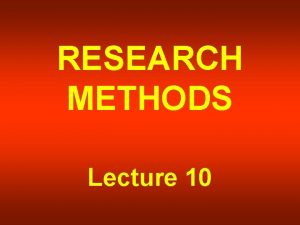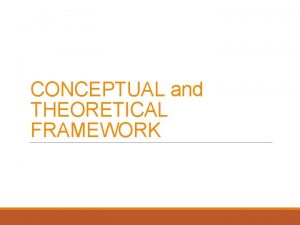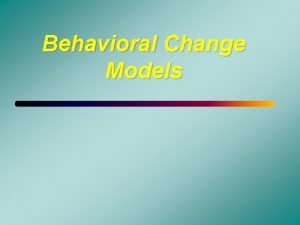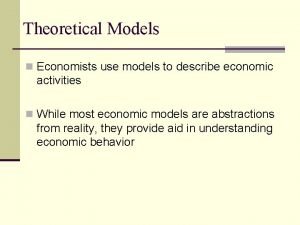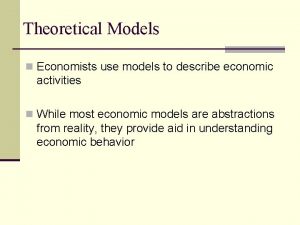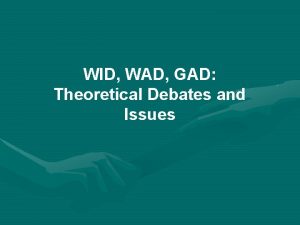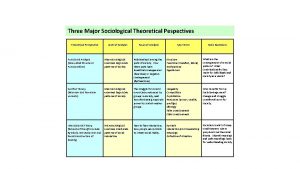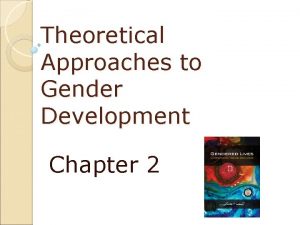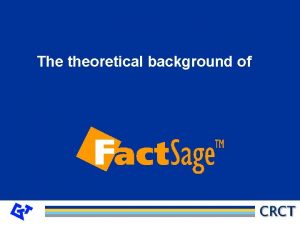Session III SW 23 A Theoretical Framework Models







































































- Slides: 71

Session III - SW 23 A Theoretical Framework/ Models of Social Policy 1

Objectives n n Explain at models of Social Policy Comparing welfare states internationally and Regionally Analyse the sorts of social policy systems that exist in the Caribbean and Conclude the best model for the nations of the Region. 2

The Welfare State n n The idea of the "welfare state" means different things in different countries. An ideal model. The "welfare state" usually refers to an ideal model of provision, where the state accepts responsibility for the provision of comprehensive and universal welfare for its citizens. 3

The Welfare State n n State welfare. Some commentators use it to mean "welfare provided by the state". This is the main use in the USA. Social protection. In many "welfare states", notably those in Western Europe and Scandinavia, social protection is not delivered only by the state, but by a combination of government, independent, voluntary, and autonomous public services. These countries are usually thought of as "welfare states". 4

Comparing Welfare States Mitchell n Comparison of policy, comparing the explicit terms in which actions are taken. Flora and Heidenheimer review the historical development of welfare in Europe and America. They find that welfare in different countries often develops on similar lines. 5

Comparing Welfare States Mitchell n n Comparison of inputs. Inputs are the resources which go into welfare provision. For example, Wilensky's work on welfare spending shows that the main determinants are the age of the system and the structure of the population. Comparing production. Different states operate different kinds of rules and structures. Esping. Andersen uses evidence on the organisation and delivery of specific services to define positions adopted by different welfare states. 6

Comparing Welfare States Mitchell n n Comparing operations. This is done by considering the detailed operation of benefits and services - what they do, how they are paid for, and who runs them. Comparing outcomes. The case can be made that what matters about welfare is not what is intended, nor what the process is, but whether or not people benefit from it. 7

The United Kingdom: The Welfare State n n Asa Briggs, in a classic essay on the British welfare state, identified three principal elements. These were: a guarantee of minimum standards, including a minimum income; social protection in the event of insecurity; and the provision of services at the best level possible. 8

The United Kingdom: The Welfare State n n ‘Institutional' model of welfare: the key elements are social protection, and the provision of welfare services on the basis of right. In practice, social welfare in the United Kingdom is very different from this ideal. Coverage is extensive, but benefits and services are delivered at a low level. The social protection provided is patchy, and services are tightly rationed. 9

Germany: The Social Market n n n The post-war German settlement was based on the idea of a 'social state', sometimes rendered as a 'social market economy'. The first, central principle was that economic development was the best way to achieve social welfare. The structure of social services had to reflect this priority. 10

Germany: The Social Market n n n The principle is represented most clearly in the close relationship of services to people's position in the labour market. Social benefits are earnings-related, and those without work records may find they are not covered for important contingencies. Less clear, but probably even more important, is the general concern to ensure that public expenditure on welfare is directly compatible with the need for economic development and 11 growth.

Germany: The Social Market n n n Second, the German economy, and the welfare system, developed through a corporatist structure. This principle was developed by Bismarck on the basis of existing mutual aid associations, and remained the basis for social protection subsequently. Social insurance, which covers the costs of health, some social care and much of the income maintenance system, is managed by a system of independent funds. 12

Germany: The Social Market n n n Third, there is a strong emphasis on the principle of "subsidiarity". This principle is taken in Germany to mean both that services should be decentralised or independently managed, and that the level of state intervention should be residual - that is, limited to circumstances which are not adequately covered in other ways. Higher earners are not covered by the main social insurance system, but are left to make their own 13 arrangements.

France: Solidarity and insertion n Social protection in France is based on the principle of solidarity: the commitment is declared in the first article of the French Code of Social Security. 14

France: Solidarity and insertion n The principle is used to refer to co-operative mutual support. Some writers apply the term in relation to 'mutualist' groups (friendly societies) and emphasise that people insured within national schemes are called to contribute and benefit on an equal footing. Others stress that relationships of solidarity are based in interdependence. Solidarity is usually understood, in this context, in terms of common 15 action, mutual responsibility and shared risks.

France: Solidarity and insertion n n The pursuit of 'national solidarity' was undertaken in the first place by attempting to extend the scope of existing solidarities, most notably through the creation of a 'régime général' for health and social security, and subsequently through its progressive expansion. Since the 1970 s this pattern of solidarities has been supplemented by additional measures designed to bring 'excluded' people into the net. 16

France: Solidarity and insertion n n The most important of these measures is the Revenu Minimum d'Insertion (RMI), introduced in 1988, which combines a basic benefit with a personal contract for 'insertion' or social inclusion. In recent years there has been a greater emphasis on "active solidarity", which puts more stress on the individual responsibility of unemployed people. 17

France: Solidarity and insertion n n This kind of arrangement is relatively expensive, and much of the focus of social policy in recent years has fallen on the control of expenditure. The main areas of concern are not dependency or unemployment, but pensions, because of the special privileges accorded to particular occupational groups, and spending on health care, where the stress on independent, market-led services presents considerable problems in cost control. 18

The United States: A 'liberal' regime n n The United States is sometimes described as a ‘liberal' welfare regime, in the sense that it represents individualism, laissez-faire, residualism and a punitive view of poverty. These issues dominate US debates on welfare: examples are the introduction of 'workfare', the exclusion of long-term benefit dependents, and the criticism of the 'underclass'. 19

The United States: A 'liberal' regime n n The US does not have a unified welfare system. Federalism has meant that many important functions are held by the various States, including public assistance, social care and various health schemes. 20

The United States: A 'liberal' regime n By comparison with other developed countries, central government has had a limited role in social welfare provision: the main developments of federal provision were during the Roosevelt administration of the 1930 s, which laid the foundations for the social security system, and the "War on Poverty" of the 1960 s, which provided some important benefits (notably health care for people on low incomes) and engaged the federal government in a wide variety of projects and activities at local level. 21

The United States: A 'liberal' regime n n The US is pluralistic, rather than liberal. There are significant departures from the residual model - e. g. state schooling, social insurance, or services for military personnel, veterans and their families, which provide for more than 60 million people. 22

The United States: A 'liberal' regime n n n In addition to federal and state activity, there are extensive private, mutualist and corporate interests in welfare provision. The resulting systems are complex (and expensive): the guiding principle is less one of consistent individualism than what Klass has called "decentralised social altruism". Diversity and complexity come at a price, and despite - or perhaps because of - political hostility to welfare provision, the US system is also unusually 23 expensive.

The United States: A 'liberal' regime n See Obamacare case study. 24

Theoretical Framework n n A collection of interrelated concepts like a theory. Guides research, determining what will be measured and what relationships sought. 25

Theoretical Frameworks (Hall & Midgely 2004, 24) 1. Representational Theory – simplifies complex social policy phenomena to promote a better understanding of different approaches to Social Policy 2. Explanatory or Analytical Theory – seeks to explain the nature of social policy and the rationale for policy decisions. Examines role of industrialisation, capitalism, social protests etc. 26

Theoretical Frameworks 3. Normative Theory – provides a value framework for social policy which identifies the values, ideologies and political objectives which underlie social policy approaches. Midgely identified three ideologies which influence three different approaches to SP Collectivism – Statist approach – -Institutional-welfarist approach Individualism – Enterprise approach Populism - Community /Empowerment Development approach 27 §

Representational Theory n n Willensky and Lebeaux (1965) – earliest model, called the Residual-Institutional model had two categories. This was modified by Titmuss who created a three-pronged model in 1974. 1. Residual Welfare Model of Social Policy 2. Industrial Achievement-Performance 3. Institutional Redistributive n n n Residual and Institutional Redistributive models are at extreme ends of spectrum Usually a blend of models is used Ideology of the political party in power, and fiscal constraints largely determine which model is applied 28

Residual Model n n n Social policy provisions begin only when private market and family fail to meet individual’s needs The basis for this model is the English Poor Laws - see Spicker (2008), G. Cumper (1987) which was punitive Concerned with providing for very needy/ poverty oriented model (selectivity) – “those who can pay, should pay” 29

Residual Model n n n Marginal role for social welfare In JA, examples are cost-sharing introduced in the mid 80 s in social services like health and education and the Programme for Advancement through Health and Education –PATH The Residual model sees welfare as being a temporary safety net. 30

Residual Model n n n Welfare intervention is meant to be temporary, to help persons while they “get back on the feet” In Jamaica a Steps to Work programme has been introduced to provide skills training to beneficiaries to reduce the time spent on PATH. Beneficiaries are re-assessed and some removed. In the US, welfare beneficiaries are expected to find work within a specified time period.

PATH n n n Targeting of the poor is utilised – Ministry of Labour and Social Security. Under PATH Means testing is used to determine eligibility for assistance, i. e. poverty status. Applicants must complete a detailed form at the PATH office. Data entered into PATH Beneficiary Identification System (BIS) and a score is generated. PATH is funded by GOJ and a World Bank Loan. Visit www. mlss. gov. jm for more details 32

PATH n n The score determines the applicant’s qualification for benefits. A home visit is then done to confirm the applicant’s status before payments begin. Conditional Transfers n Beneficiaries must fulfill obligations to receive benefits certain

PATH n n n Children on PATH must have 85% school attendance (should not be absent for more than 3 days per month) and must fulfill a schedule of health centre visits. Adults also have to attend their health centre at specified periods. This approach aims to increase the human capital of the poor and break the intergenerational transmission of poverty.

PATH Beneficiaries n Children: from birth to completion of secondary education; a post-secondary training grant of $15, 000 just introduced n Elderly: 60 years or over, and not in receipt of a pension n Persons with Disabilities n Pregnant and Lactating Women n Poor Adults 18 -59 years n Trinidad has a similar programme called their Conditional Cash Transfer Programme (CCTP) uses a swipe card

PATH monthly cash transfers for children paid every other month (1 June 2010) Grade Boys Girls 1 to 6 $825. 00 $750. 00 7 to 9 $1, 075. 00 $975. 00 10 to 13 $1, 265. 00 $1, 150. 00 n Children 0 to 6 years receive $750. 00 per month. All other beneficiaries receive $900. 00 per month. n For secondary school children GOJ may pay the auxillary fees if parents apply to PATH for assistance, but this help is not automatic.

PATH n n Between December 2002 and August 2008, the value of the PATH grants was standardized for all categories of beneficiaries. In December 2008, the system of differentiated benefits was introduced for children receiving Education Grants, to encourage school attendance and school retention at the secondary level.

PATH n n n Children who do not meet the attendance requirements will be deemed non-compliant and the PATH benefit will be withdrawn. A base benefit of $400. 00 per month was introduced in June 2010 to assist noncompliant beneficiaries. The remainder of the benefit is paid upon achievement of the required compliance conditionalities. 38

PATH n n Children who go to school receive nutritional support. PATH sends money to school for lunch for PATH beneficiaries but money only covers lunch for 2 -3 days per week 39

PATH n n Cabinet gave approval in March 2011 for 4, 000 children in government-run pre-primary institutions to be added to PATH’s Nutritional Support Project. Twenty eight point eight million dollars was allocated for the programme in the 2011/2012 budget. 40

PATH n n n Post Secondary School Grant In October 2009, PATH introduced a grant of $15, 000 to assist PATH students who are transitioning from a secondary to a postsecondary institution. This is a one-time grant which is provided to assist PATH students who have graduated from a secondary school and who are moving on to post secondary training. 41

PATH n n JLP vowed to revise PATH to include postsecondary level students during the last election campaign. The PM (Andrew Holness) felt that persons are most vulnerable to making bad decisions between the ages of 16 and 20, but there is no social welfare programme for those in this age group. 42

Industrial Achievement-Performance Model n n n Historically the IAP model operated in state-controlled economies such as former Socialist countries, but it also operates in capitalist states of Germany, France and Asian Tigers and other countries worldwide. Social policy provisions are tied closely to economy (handmaiden model) and production goals. The 'handmaiden' model, sees welfare as an essential complement to industrial development: social policy helps the economy to grow by serving the workforce, providing services to industry and offering a secure basis for development. 43

Industrial Achievement-Performance Model n n Based on Keynesian economics that sees spending on welfare as a useful economic regulator, helping to balance the economy in periods of recession. However, Atkinson (1995) shows that although developed countries generally spend more on welfare than less developed countries, developed countries with higher welfare spending do not generally do better or worse than developed countries which spend less. 44

Industrial Achievement-Performance Model n Merit and performance guide provision of social security payments like public pensions, social insurance. E. g. in Ja include National Insurance Scheme (NIS) NI Gold Health Insurance for pensioners, National Housing Trust. n Pension and housing benefits depend on level of contribution n On 15 February 2012 Min. of Health Dr. Fenton Ferguson said that free health care will go. “Those who can pay should be required to pay. Those who cannot afford to pay, the State has an inescapable obligation to cover the cost associated with that care… GOJ card does not indicate whether patients have used their cards before in Sav-la-mar…” 45

Industrial-Achievement Performance model n n n Other forms of income maintenance, e. g. unemployment benefits, invalidity and disability benefits are provided in the model Education and Healthcare provided for all, e. g. Cuba, Barbados, to build human capital. Social policy is an important partner to the economy. Aim is to develop human capital, ensure unity, solidarity and commitment of workers. 46

Institutional Redistributive Model n n n (Welfare State) This model developed after World War II to facilitate rebuilding lives, supporting growth and full employment. British welfare state introduced in 1948. Premised on notion that citizens of a country have a basic right to welfare (Marshall). Social welfare institutions are integrated and institutionalized parts of society 47

Institutional Redistributive Model n n The Institutional model sees need and states of dependency e. g. infancy, childhood and old age, as normal aspects of social life. This approach is based on acceptance of mutual social responsibility for these needs and the general provision for all. (Spicker, 2008). 48

Institutional Redistributive Model n n (Welfare State) Provides universalistic services outside of the market and is based on individual needs. Scandanavian countries have the best welfare states today. 49

Sweden: The Institutional. Redistributive model n n n Titmuss' 'institutional-redistributive' model combines the principles of comprehensive social provision with egalitarianism. This is an "ideal type", rather than a description of reality. Social protection is not necessarily associated with equality; the French and German systems offer differential protection according to one's position in the labour market. 50

Sweden: The Institutional. Redistributive model n n The Swedish model can be seen as an ideal form of 'welfare state', offering institutional care in the sense that it offers universal minima to its citizens. It goes further than the British model in its commitment to social equality. Sweden has the highest level of spending on social protection in the OECD, and the lowest proportion of income left to independent households - less than half its national income. 51

Sweden: The Institutional. Redistributive model n n The Swedish system, looked at in greater detail, has many of the same characteristics: Ringen describes the system as "selective by occupational experience". However, the importance of equality - sometimes identified with 'solidarity', in the sense of organised co-operation - is considerable. 52

Sweden: The Institutional. Redistributive model n The model of this is the 'solidaristic wage policy' advocated by the labour movement, which emphasised improving standards, limited differentials, and redistribution. 53

Institutional Redistributive Model (Welfare State) n In Jamaica, examples of this type include: n free primary education, n free tuition at secondary level, (not free education) n free healthcare in public facilities, n Jamaica Drugs for the Elderly and the National Health Fund subsidies on prescriptions n School textbook programmes 54

Institutional Redistributive Model (Welfare State) n n Central government to limit itself to the making of general policy, and the laying down of general rules, for the government cannot know the intricacies of individual merits and factors within a situation. Weaknesses of welfare provision: · individual initiatives are sapped · Freidman - expenditures have increased markedly, with ‘better off’ being favoured; political expediency drives the welfare state, and therefore voucher system would be of benefit, especially to poor 55

Institutional Redistributive Model (Welfare State) Public tends to support the welfare state while opposing state intervention in the economy Thus: · privatisation to be encouraged (IMF) · spending as a proportion of GDP to be reduced (IMF) · there should be a return to real family values · there should be a reduction in taxation n 56

Institutional Redistributive Model (Welfare State) n Ideological factors: welfare cuts - likely to gain approval if: · presented in the context of approval of nonintervenionist state rather than attack on social provision · cuts more likely to be favoured if focussed on unfavoured groups · community care more marketable if presented as rolling back of state rather than imposition on middle aged women (bulk of care-givers) 57

Institutional Redistributive Model (Welfare State) n Long term goals: · remove state monopoly on welfare provision · transform state from provider to regulator · facilitate state provision only for those who ‘need’ it · ensure changes introduced are unassailable · supply side must be expanded to include many suppliers, and ownership must be to private provision. 58

Gosta Esping-Andersen’s Model of Welfare (1990) Updated Titmuss’ model n n 1. Liberal – similar to Residual model 2. Conservative-Corporatist – similar to Industrial Achievement-Performance model 3. Social democratic – similar to Institutional Redistributive model 4. Mediterranean model 59

Gosta Esping-Andersen’s Model of Welfare (1990) n n Thinking point - students to review the three models and look at the Mediterranean model. Note critiques 60

Liberal Regime – US, Canada n n n Modest public welfare spending Private social services on the free market and occupational welfare encouraged Heavy reliance on family, church and charities Minimizes decommodification (degree to which individuals or households can enjoy an acceptable standard of living independently of engaging in the market) Welfare payments to poor are means-tested, conditional transfers 61

Conservative-Corporatist Regime – Germany, France n n n Heavy reliance on social security provisions e. g. pensions, health insurance. Also involves a social contract between the state, labour and private sector to control wages and prices. Church, family, voluntary organisations also involved in social service provisions 62

Social Democratic Regime – Scandinavian countries n n n High level of state social protection for all Sweden arguably the highest level of state provision The “Swedish Model”, is intended to secure a fair, socially acceptable distribution of income and wealth and the eradication and absence of poverty without jeopardizing economic efficiency and growth in the long run. (Gylfason et al, 1997: 13 cited in Tepe, 2005) 63

Social Democratic Regime – Scandinavian countries n n Secured gender equality in the labour market Pension reform repealed the income test and pension payments became universal, flat-rate and state-financed - men and women had equality in retirement pensions (Tepe, 2005) 64

Mediterranean Regime – Italy, Greece, Spain n The family’s role in the provision of social welfare is important. 65

Political/Ideological Influences n n n Left-leaning – includes collectivists like the Social Democrats, Socialists, and Marxists These groups tend to favour institutional welfare systems Right leaning- includes Christian Democrats, Conservatives, Neo-liberals - they are individualist and tend to favour residual welfare. n Privatized or market provision of social services n 66

Political/Ideological background n Political centre- believes in the “social market”, e. g. Germany n Negative effects of free market should be moderated by strategic state intervention in the economy and the use of strong social protection systems. These use the IAP and also the Social Democratic model. 67

Residual Model Strengths n Low Cost n Reduces burden on state Weaknesses § Stigmatization § Access – limited advertising of benefits, those in need may not be aware of programmes 68

Residual Model n n n Selectivity requires expensive administrative process Leakage Safety nets can lead to a poverty trap, as a rise in income usually leads to a loss of welfare benefits 69

Industrial-Achievement performance Model Strengths n n Incentivizes work Protects against contingencies like disability and unemployment Weaknesses n Neglects those outside the labour market n Pensions and insurance usually dependent on position in the labour market - lower paid workers may be marginalised. 70

Strengths n n Institutional Model Strong Protection for all High investment in human capital Weaknesses n Expensive, requires high taxes n May reinforce the status quo, may not achieve equity n Public health and education provisions are often rigid and may not address specialised 71 needs
 Conceptual framework theoretical framework
Conceptual framework theoretical framework Conceptual framework vs theoretical framework
Conceptual framework vs theoretical framework Theoretical framework vs conceptual framework
Theoretical framework vs conceptual framework Framework sample
Framework sample Cognitive approach vs behavioral approach
Cognitive approach vs behavioral approach Hamlet act iii scene iii
Hamlet act iii scene iii Theoretical framework and hypothesis
Theoretical framework and hypothesis Theoretical framework example
Theoretical framework example 4 levels of parenting
4 levels of parenting Contoh theoretical framework
Contoh theoretical framework Theoretical framework example
Theoretical framework example Schematic diagram of theoretical framework
Schematic diagram of theoretical framework How to write theoretical framework
How to write theoretical framework Framework hypothesis
Framework hypothesis Conceptual framework for tracer study
Conceptual framework for tracer study Theoretical framework
Theoretical framework Theoretical framework for comparative study
Theoretical framework for comparative study Theoretical and conceptual framework in research example
Theoretical and conceptual framework in research example Theoretical framework independent dependent variable
Theoretical framework independent dependent variable Research framework example
Research framework example Conceptual and theoretical framework
Conceptual and theoretical framework Theoretical framework example
Theoretical framework example Theoretical framework and hypothesis development
Theoretical framework and hypothesis development Hypotheses development
Hypotheses development Rationale of the study
Rationale of the study Shall will difference
Shall will difference Dispositional framework vs regulatory framework
Dispositional framework vs regulatory framework Dispositional framework vs regulatory framework
Dispositional framework vs regulatory framework Load density in hashing
Load density in hashing Dislocation glide vs climb
Dislocation glide vs climb How to find the theoretical probability
How to find the theoretical probability Flow time analysis
Flow time analysis How to find the percent error
How to find the percent error Percent yield formula
Percent yield formula What is random experiment
What is random experiment Actual-theoretical/actual
Actual-theoretical/actual Theoretical molar mass of butane
Theoretical molar mass of butane Theoretical background sample
Theoretical background sample Theoretical probability examples
Theoretical probability examples Contingency theory strengths and weaknesses
Contingency theory strengths and weaknesses Making predictions with theoretical probability
Making predictions with theoretical probability Generic purposive sampling
Generic purposive sampling Diederik rousseau
Diederik rousseau Theoretical flow time for alternative paths
Theoretical flow time for alternative paths How to find theoretical yeild
How to find theoretical yeild Probability of simple events
Probability of simple events Brown and clough theory on group living
Brown and clough theory on group living Great theoretical ideas in computer science
Great theoretical ideas in computer science Operational vs theoretical definition
Operational vs theoretical definition Hplc chromatography introduction
Hplc chromatography introduction Great theoretical ideas in computer science
Great theoretical ideas in computer science Cmu 15251
Cmu 15251 Comparing experimental and theoretical probability
Comparing experimental and theoretical probability Theoretical maximum capacity
Theoretical maximum capacity Theoretical probability
Theoretical probability Theoretical probability formula
Theoretical probability formula Theoretical wisdom
Theoretical wisdom Qualitative research
Qualitative research Theoretical probability distribution
Theoretical probability distribution How to find theoretical probability
How to find theoretical probability List of theoretical frameworks
List of theoretical frameworks 13-1 practice experimental and theoretical probability
13-1 practice experimental and theoretical probability Utrecht theoretical physics
Utrecht theoretical physics Applied linguistics
Applied linguistics Ex rights price
Ex rights price Theoretical yield def
Theoretical yield def 11-2 theoretical and experimental probability
11-2 theoretical and experimental probability In computer
In computer Great theoretical ideas in computer science
Great theoretical ideas in computer science Three major sociological perspectives
Three major sociological perspectives Great theoretical ideas in computer science
Great theoretical ideas in computer science Theoretical foundations of transcultural nursing
Theoretical foundations of transcultural nursing








